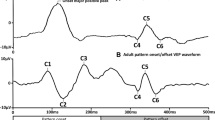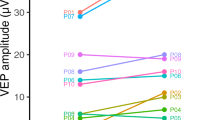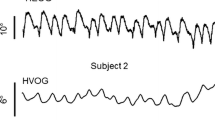Abstract
Purpose: The visual evoked potential is often used to assess visual function in neurologically impaired patients, a group in whom nystagmus is a common feature. Pattern-reversal stimuli are commonly used to produce visual evoked potentials in clinical practice. Previous reports have shown that this stimulus is not optimal when subjects have nystagmus. The present study aimed to compare the efficacy of pattern-onset and reversal stimuli when used to measure visual evoked potentials from subjects with idiopathic nystagmus.Methods: In five adults with congenital nystagmus and 10 visually normal adults, VEPs were recorded and reproduced for checkerboard stimuli of two sizes (120′ and 60′). Each size was presented as both pattern-onset and reversal check.Results: Visually normal adults demonstrated similar visual evoked potential amplitudes and quality in response to pattern-reversal and pattern-onset. However, in the presence of nystagmus, visual evoked potentials recorded to pattern-reversal stimuli were significantly smaller and of poorer quality than those obtained to pattern-onset stimuli (analysis of variance p<0.05; Kendall's tau, p<0.05).Conclusions: Pattern-onset stimuli produce larger and clearer visual evoked potentials in patients with nystagmus compared with those produced to pattern-reversal stimuli.
Similar content being viewed by others
References
Moskowitz A, Sokol S. Developmental changes in the human visual system as reflected by the latency of the pattern reversal VEP. Electroencephalogr Clin Neurophysiol 1983; 56: 1–15.
Mohn G, van Hof van Duin J. Behavioural and electrophysiological measures of visual functions in children with neurological disorders. Behav Brain Res 1983; 10: 177–87.
Bane MC, Birch EE. VEP acuity, FPL acuity and visual behaviour of visually impaired children. J Pediatr Ophthalmol Strabismus 1992; 29: 202–29.
Odom JV, Green M. Visually evoked potentials (VEP) acuity: testability in a clinical pediatric population. Acta Ophthalmol 1984; 62: 93–8.
Mackie RT, McCulloch DL. Assessment of visual acuity in multiply handicapped children. Br J Ophthalmol 1995; 79: 260–9.
Kennerly Bankes JL. Eye defects of mentally handicapped children. Br Med J 1974; 2: 533–5.
LoCasio GP. A study of vision in cerebral palsy. Am J Optom Physiol Opt 1977; 54: 332–7.
Black P. Visual disorders associated with cerebral palsy. Br J Ophthalmol 1982; 66: 46–52.
Schiemann M. Optometric findings in children with cerebral palsy. Am J Optom Physiol Opt 1984; 61: 321–3.
Maino DM, Maino JH, Maino SA. Mental retardation syndromes with associated ocular defects. J Am Optom Assoc 1990; 61: 707–16.
Keith CG, Kitchen WH. Ocular morbidity in infants of very low birth weight. Br J Ophthalmol 1983; 67: 302–5.
Gibson NA, Fielder AR, Trounce JQ, Levene MI. Ophthalmic findings in infants of very low birthweight. Dev Med Child Neurol 1990; 32: 7–13.
Gallo JE, Lennerstrand G. A population-based study of ocular abnormalities in premature children aged 5 to 10 years. Am J Ophthalmol 1991; 111: 539–47.
Pike MG, Holmstrom G, De Vries LS, Pennock JM, Drew KJ, Sonksen PM, Dubowitz LMS. Patterns of visual impairment associated with lesions of the preterm infant brain. Dev Med Child Neurol 1994; 36: 849–62.
Creel D, Spekreijse H, Reits D. Evoked potentials in albinos: efficacy of pattern stimuli in detecting misrouted optic fibres. Electroencephalogr Clin Neurophysiol 1981; 52: 595–603.
Apkarian P, Reits D, Spekreijse H. A decisive electrophysiological test for human albinism. Electroencephalogr Clin Neurophysiol 1983; 55: 513–31.
Kriss A, Russell-Eggitt I, Harris CM, Lloyd IC, Taylor D. Aspects of albinism. Ophth Ped Gen 1992; 13: 89–100.
Kriss A, Russell-Eggitt I, Taylor D. Childhood albinism. Visual electrophysiological features. Ophthalmic Pediatr Genet 1990; 11: 185–92.
Zubcov AA, Fendick MG, Gottlob I, Wizov SS, Reinecke RD. Visual-evoked cortical potentials in dissociated vertical deviation. Am J Ophthalmol 1991; 112: 714–22.
Arlt A, Zangemeister WH. Influence of slow eye movement and nystagmus on pattern induced visual evoked potentials. Neuroophthalmol 1990; 10: 241–51.
Rosenberg ML, Jabbari B. Nystagmus and visual evoked potentials. Neuroophthalmol 1987; 7: 133–8.
Mackie RT, McCulloch DL, Saunders KJ, Ballantyne J, Day RE, Bradnam MS, Dutton GN. Comparison of visual assessment tests in multiply handicapped children. Eye 1995; 9: 136–41.
Harding GFA, Odom JV, Spileers W, Spekreijse H. Standard for visual-evoked potentials. Vision Res 1996; 36: 567–72.
Chung STL, Bedell HE. Congenital nystagmus image motion: influence on visual acuity at different luminances. Opt Vision Sci 1997; 74: 266–72.
Armington JC, Bloom MB. Relations between the amplitudes of spontaneous saccades and visual responses. J Opt Soc Am 1974; 64: 1263–71.
Saunders KJ, McCulloch DL, Mackie RT. Pattern onset VEPs from paediatric patients with nystagmus. Presented at the ISCEV XXXIII Symposium, Athens, Greece, June 1995.
Author information
Authors and Affiliations
Rights and permissions
About this article
Cite this article
Saunders, K.J., Brown, G. & McCulloch, D.L. Pattern-onset visual evoked potentials: more useful than reversal for patients with nystagmus. Doc Ophthalmol 94, 265–274 (1997). https://doi.org/10.1007/BF02582984
Received:
Issue Date:
DOI: https://doi.org/10.1007/BF02582984




